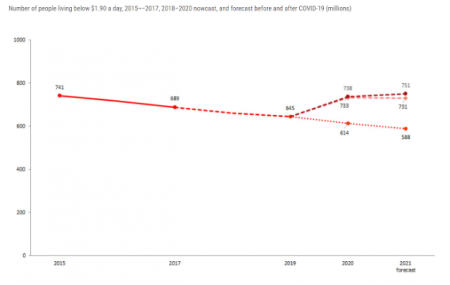While for the second year now we have been tracking new numbers of coronavirus-related cases and deaths several times a day, and estimates for the cost of the economic lockdown range between two and four billion CZK a day (for the Czech Republic), another crucial figure has escaped our attention.
That figure is absolute global poverty, that is, the percentage of the world’s population with a daily disposable income of less than USD 1.90 a day. As World Bank data show, this figure has been falling steadily for the last forty years, including during the last financial crisis. Thus, in 2017, less than a tenth of the world’s population lived in absolute poverty.
Figure 1: Percentage of the world’s population with disposable income of USD 1.90 a day
The pandemic reversed this trend. A year-old preliminary calculation in January 2021 showed that the pandemic had plunged an additional 119 to 124 million people into absolute poverty in 2020, and a subsequent calculation in June showed that, although the original estimate was too pessimistic, an additional 97 million people were likely to actually be in absolute poverty.
The rollout of coronavirus vaccines and the overall relaxation of measures slowed the growth of poverty in 2021, but we still expect the situation to worsen further in 2021. In the longer term, the consequence of the pandemic will be that instead of the original goal of eradicating absolute poverty globally by 2030, we can realistically expect 7% of the world’s population (600 million people) to remain in poverty in that year.
Figure 2: Number of people (in millions) living on USD 1.90 a day, including an estimate for 2018-2020 and a prediction for 2021
Another important fact is that sixty percent of the newly poor come from South Asia. While the plight of many individuals and households in the Czech Republic cannot be downplayed, virtually no one in Europe is at risk of absolute poverty.
Labor productivity and living standards are high enough here, the labor market saturated, savings decent and the welfare system robust enough that even the poorest Czechs are far from living on two dollars a day.
The same is not true for South Asians. Locals can’t afford to sit out of the job market for months at a time and don’t have the option of going to a home office. Local governments, therefore, have far less room for maneuver than European governments when introducing measures, which is not made any easier by the fact that South Asians are far from being affected by local regulation alone.
Europe is the market for around a fifth of regional exports, and another fifth of exports from South Asia go to North America. The pandemic has, of course, brought with it a natural change in consumer behavior, but trade and movement restrictions have contributed to this, resulting in a one-third year-on-year decline in trade relative to GDP in the worst affected region.
It can still be seen as a positive that despite the significant increase in global poverty, this is still only a return to 2016. So, the pandemic has only cost us five years of fighting poverty so far. This cost could have been less if the governments of the rich world had not resorted to coronavirus nationalism, and had not started to restrict trade and introduce protectionist policies under the guise of protectionist measures.
Not only do such actions contribute substantially to the growth of poverty in the world, but they also impoverish the people of the rich countries in the long term.
Continue exploring:
Polish Tax System, Second Worst in OECD
Competition Is Like Adidas Stripes, More Is Not Always Better





